Nikon AF-S DX Nikkor 18-300mm f/3.5-6.3G Review
Nikon AF-S DX Nikkor 18-300mm f/3.5-6.3G ED VR Performance
At 18mm and maximum aperture, sharpness is very good in the centre of the frame, and falling just short of good levels towards the edges of the frame. Stopping down to between f/5.6 and f/8 produces outstanding sharpness in the centre of the frame, but the clarity delivered at the edges of the frame never really improves beyond good levels at this focal length.At 70mm, sharpness is very good in the centre of the frame at maximum aperture, with performance towards the edges only reaching fairly good levels. Stopping down produces a dramatic improvement in performance across the frame, with sharpness being outstanding in the centre and excellent towards the edges of the frame between f/8 and f/11.
Finally, at 300mm, sharpness remains very good in the centre of the frame between f/6.3 and f/11, although performance towards the edges of the frame never really exceeds fairly good levels at this focal length.
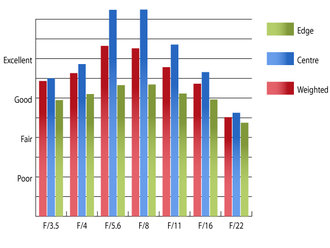 MTF@18mm |
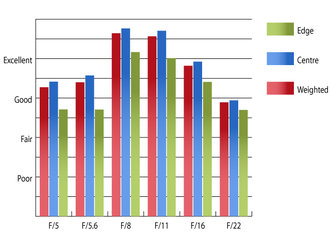 MTF@70mm |
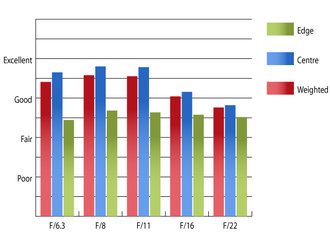 MTF@300mm |
How to read our chartsThe blue column represents readings from the centre of the picture frame at the various apertures and the green is from the edges. Averaging them out gives the red weighted column.The scale on the left side is an indication of actual image resolution. The taller the column, the better the lens performance. Simple. For this review, the lens was tested on a Nikon D7100 using Imatest. |
Levels of chromatic aberrations are an issue for this lens towards the edges of the frame, throughout the zoom range. Fringing is at its most prevalent at 300mm towards the edges of the frame, where it exceeds two pixel widths. This level will be clearly visible along high contrast areas towards the edges of the frame.
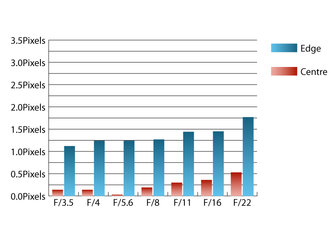 CA@18mm |
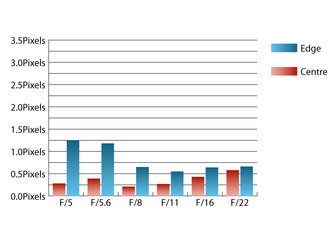 CA@70mm |
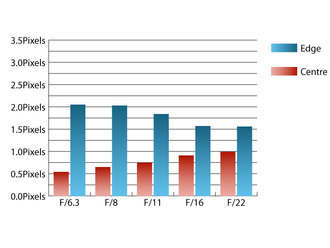 CA@300mm |
How to read our chartsChromatic aberration is the lens' inability to focus on the sensor or film all colours of visible light at the same point. Severe chromatic aberration gives a noticeable fringing or a halo effect around sharp edges within the picture. It can be cured in software.Apochromatic lenses have special lens elements (aspheric, extra-low dispersion etc) to minimize the problem, hence they usually cost more. For this review, the lens was tested on a Nikon D7100 using Imatest. |
Falloff of illumination towards the corners of the frame is well controlled for a lens of this type. At 18mm the corners are 1.54 stops darker than the image centre and at 300mm the corners are 1.37 stops darker. Visually uniform illumination is achieved with the lens stopped down to f/8 or beyond throughout the zoom range.
As is often the case with super zoom lenses, distortion is at both ends of the range, although it isn't overly disturbing with this lens. At 18mm 4.5% barrel distortion is present, which is a reasonably high level and at 300mm 1.1% pincushion distortion is present, which is less noticeable. The distortion pattern is uniform across the frame, so any distortion should be relatively easy to correct in image editing software afterwards if required.
A petal-shaped hood is supplied with the lens, which does a decent job of shielding the front element from extraneous light that may cause flare or loss on contrast. Shooting into the light does result in a slight loss of contrast, especially at 300mm, but otherwise, this lens is quite resistant to flare.
Value For Money
This 18-300mm lens costs around £615, which is quite reasonable for a newly released lens. The older bulkier version, that sports an f/5.6 maximum aperture at 300mm, is a touch more expensive at around £630, even though the price has dropped drastically since launch. Nikon's current 18-200mm lens is similarly specified, except for the maximum telephoto setting being 200mm and costs around £580.The closest offering Sigma produce is their 18-250mm f/3.5-6.3 DC OS HSM lens, which costs around £300. It has a maximum telephoto setting of 250mm. This lens also includes an optical stabiliser and a silent focusing motor, although manual focus override is only possible by switching the lens to its manual focus setting.
Finally, Tamron's 18-270mm f/3.5-6.3 Di II VC PZD lens is their closest offering, which costs around £330. There is a 30mm difference at the telephoto setting. This lens also includes vibration compensation and a silent focusing motor, although full time manual focus override isn't possible, just like with the Sigma lens.
Add your message
Login required
Please login here or if you've not registered, you can register here. Registering is safe, quick and free.
Please login here or if you've not registered, you can register here. Registering is safe, quick and free.
photodo Stats
1102 lenses
428 MTF tests
74 in-depth photodo reviews
100+ users join each day
Help the lens community by reviewing or rating a lens today via our lens search
428 MTF tests
74 in-depth photodo reviews
100+ users join each day
Help the lens community by reviewing or rating a lens today via our lens search
Latest Lens Reviews
- Chinon 28mm f/2.8 Vintage Lens Review
- Canon EF 70-200mm f/4L IS II USM Lens Review
- Samyang AF 85mm f/1.4 EF Review
- Sigma 70mm f/2.8 DG Macro Art Review
- Samyang AF 24mm f/2.8 FE Review
- Meike 50mm f/1.7 Review
- Tamron 70-210mm f/4 Di VC USD Review
- Lensbaby Burnside 35mm f/2.8 Review
- Asahi Super Takumar 50mm f/1.4 Review
- Asahi Super-Multi-Coated Takumar 135mm f/3.5 Review
